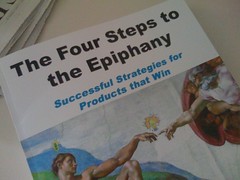Finding the Button
by Holland-Mark | February 2, 2011
Our Venture Branding program is really coming into focus now, thanks in part to the steady stream of interest we’ve had from local startups, and the influence of our friends at both the New England Venture Capital Association, and the Bain Capital Innovation Center.
Holland-Mark’s approach to startup marketing is heavily influenced by our own collective startup experience, and by the work of Stanford University’s Steven Gary Blank. Blank coined the term “Customer Development” in his seminal book Four Steps to the Epiphany, referring to a style of entrepreneurship focused on the rapid, iterative refinement of a product based on early and frequent contact with external reality. From Wikipedia’s summary:
Customer Development is a risk reduction methodology for early stage startups. Its premise is that startups are not smaller versions of large companies. Instead these early stage ventures require new tools and techniques. Key tenets are: constant contact with potential customers, continual product iteration by shipping as early as possible for product refinement based on customer feedback. Cash burn is kept low until the onset of adoption at which point additional funding can be sought to refine the model and to scale a proven model. Customer Development has four steps:
- Customer Discovery focuses on understanding customer problems and needs,
- Customer Validation on developing a sales model that can be replicated,
- Customer Creation on creating and driving end user demand, and
- Company Building on transitioning the organization from one designed for learning and discovery to a well-oiled machine engineered for execution. (Blank, 2006).
Customer Development works in parallel with Agile Development Methodologies to create products.
In our loose translation… while every startup is different, most begin as a kind of passionate hypothesis about the world and what it needs. The work of an entrepreneur is first and foremost to advance that hypothesis among a group of people necessary to prove or disprove it, and in the process to shape and evolve it in the direction of the objective truth.
Successful early stage entrepreneurs have the skills, insight, and experience to balance two forces in constant conflict in the early stage venture: the conviction required to will anything that does not exist into reality, and the flexibility necessary to adapt a new offering to the objective truth of the market as it comes into focus.
Doing so effectively gets you to a critical point in the evolution of a successful startup, a point we call finding the button.
Finding the Button
“Finding the button” is the point at which an entrepreneur has proven to herself that a specific group of people will pay enough to solve a specific problem to make doing so worthwhile for her. Sometimes called “Product Market Fit,” it is the point at which the entrepreneur’s central challenge shifts from uncovering the real opportunity to capitalizing on it; where the emphasis shifts from selling his vision to telling a story he knows will cause the right people to buy.
The Venture Branding program is built for startups at this stage of development. Before crossing this threshold, professional marketing communications is not only prohibitively expensive, it risks locking in a hypothesis that may or may not survive contact with the real world. At this threshold, however, the availability of external capital tends to dovetail neatly with awareness that a failure to invest in achieving genuine clarity of message threatens the viability of a still emerging business.
Are you at this stage? Do you need help telling your story? And can you pay for professional help with a balanced mix of cash and equity?
If so drop me a line, I’d love to talk.
Related articles
- Should We Celebrate Startup Success? (eveningwalk.blogspot.com)
- Steve Blank: Startups Are Not Small Versions Of Large Companies: Towards A Science Of Entrepreneurship (huffingtonpost.com)
- Detailed notes from StartupLessonsLearned conference 2010 (docs.google.com)
- 2011 may mark the beginning of a golden era for entrepreneurs (venturebeat.com)
- Is there too much emphasis on scalable startups? (feldmanfile.blogspot.com)


